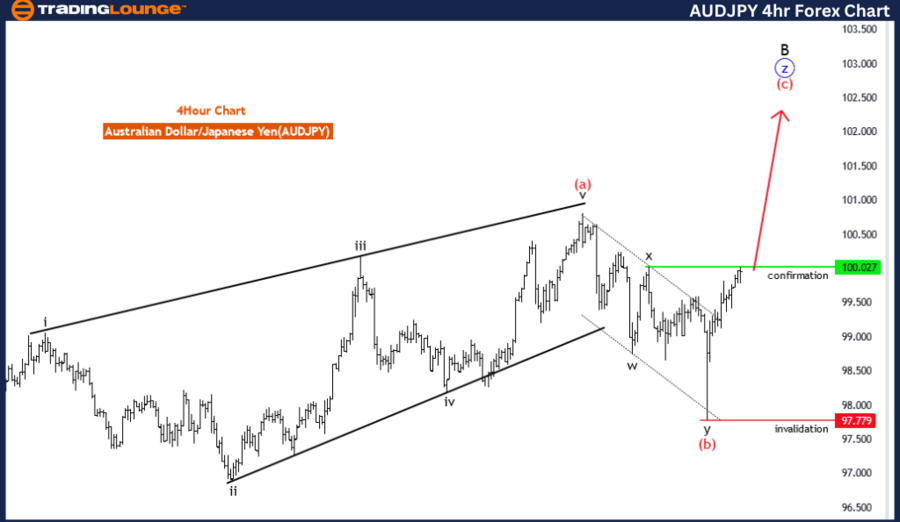Australian Dollar/Japanese Yen (AUDJPY) Day Chart
AUD/JPY Elliott Wave technical analysis
Function: Counter Trend.
Mode: Impulsive as C.
Structure: Red wave C.
Position: Blue Wave Z.
Direction next lower degrees: Black wave C.
Details: Red wave B of Z looking completed, now red wave C of Z of B looking started. Wave Cancel invalid level:97.779.
The AUD/JPY Elliott Wave Analysis for the Day Chart provides an overview of the current market trend and likely future developments in the Australian Dollar/Japanese Yen currency pair, utilizing the principles of Elliott Wave Theory.
Function
The function of this analysis is described as "Counter Trend." This indicates that the current wave structure represents a corrective move against the primary trend. Counter-trend movements often suggest a retracement or a temporary shift in market direction.
Mode
The mode for this chart is specified as "impulsive as C." This mode denotes a stronger directional movement within the Elliott Wave structure, indicating that the current counter-trend may contain a significant shift or wave progression.
Structure
The structure is identified as "red wave C," which typically indicates the final stage of a corrective pattern. This aligns with the function of the analysis, pointing towards a potential transition from correction to a new impulsive phase.
Position
The position within the broader Elliott Wave structure is "blue wave Z." This position implies that the current pattern is in a complex corrective phase, potentially consisting of multiple interconnected corrective waves.
Direction for the next lower degrees
The analysis suggests that the next lower degree trend is toward "black wave C." This provides a directional cue, indicating where the trend is likely to head following the current wave structure.
Details
The analysis mentions that "red wave B of Z" appears to be completed, suggesting that a key part of the corrective cycle has ended. This is significant because it denotes the beginning of a new phase, specifically "red wave C of Z of B." This structure could represent the start of a more substantial movement within the current Elliott Wave pattern, indicating a shift in momentum.
The "Wave Cancel invalid level" is listed at 97.779. This level is crucial for understanding where the current wave structure might break down. If the market moves past this point, the current analysis could be invalidated, requiring a new interpretation of the Elliott Wave structure.
In summary, the analysis outlines a transition in the AUD/JPY pair from a corrective phase to a potentially more impulsive structure. It provides key points to watch for traders and analysts, indicating possible changes in market direction. The critical invalidation level gives traders a boundary for risk management, serving as a guide for trading decisions and strategy adjustments.
Australian Dollar/Japanese Yen (AUDJPY) 4 Hour Chart
AUD/JPY Elliott Wave technical analysis
Function: Counter Trend.
Mode: Impulsive as C.
Structure: Red wave C.
Position: Blue Wave Z.
Direction next higher degrees: Red wave C (started).
Details: Red wave B of Z looking completed, now red wave C of Z looking started . Wave Cancel invalid level:97.779.
The AUD/JPY Elliott Wave Analysis for the 4-Hour Chart provides insights into the current market trends and future projections for the Australian Dollar/Japanese Yen currency pair using the Elliott Wave Theory.
Function
The function of this analysis is identified as "Counter Trend." This suggests that the current market structure is moving in opposition to a broader, larger trend. Counter-trend movements often signal corrections or retracements within a larger trend.
Mode
The mode described in this analysis is "impulsive as C," indicating that the ongoing wave pattern is impulsive and represents a final phase of a correction. Impulsive waves generally signify more substantial and direct price movements within the Elliott Wave structure.
Structure
The structure for this analysis is noted as "red wave C," indicating that the market is in the final phase of a corrective cycle. This structure aligns with the counter-trend function, suggesting a more substantial correction in progress, possibly signaling the beginning of a new trend or the resumption of the broader trend.
Position
The position within the Elliott Wave cycle is listed as "blue wave Z," indicating a higher degree of complexity and possible combination patterns. This is part of a larger structure that often involves multiple corrective waves interconnected in a larger pattern.
Direction for the next higher degrees
The analysis points towards "red wave C," indicating that the current impulsive phase could lead to a broader continuation of the trend, suggesting a transition from correction to impulsion.
Details
The details provided in the analysis indicate that "red wave B of Z" is looking completed, suggesting that a key part of the correction phase has ended. The analysis identifies that "red wave C of Z" is likely beginning, which represents a more substantial impulsive movement in the current cycle. This is a potential signal for traders to watch for continuation patterns.
The "Wave Cancel invalid level" of 97.779 is crucial. This level acts as a boundary; if breached, the current Elliott Wave pattern becomes invalid, necessitating a re-evaluation. This invalidation level is critical for traders and analysts as it guides their risk management strategies.
In summary, the analysis describes a complex Elliott Wave structure, focusing on the transition from a corrective phase to a more impulsive one. It underscores significant points for traders to watch, indicating potential directional shifts in the market.
Technical analyst: Malik Awais.
AUD/JPY Elliott Wave technical analysis [Video]
As with any investment opportunity there is a risk of making losses on investments that Trading Lounge expresses opinions on.
Historical results are no guarantee of future returns. Some investments are inherently riskier than others. At worst, you could lose your entire investment. TradingLounge™ uses a range of technical analysis tools, software and basic fundamental analysis as well as economic forecasts aimed at minimizing the potential for loss.
The advice we provide through our TradingLounge™ websites and our TradingLounge™ Membership has been prepared without considering your objectives, financial situation or needs. Reliance on such advice, information or data is at your own risk. The decision to trade and the method of trading is for you alone to decide. This information is of a general nature only, so you should, before acting upon any of the information or advice provided by us, consider the appropriateness of the advice considering your own objectives, financial situation or needs. Therefore, you should consult your financial advisor or accountant to determine whether trading in securities and derivatives products is appropriate for you considering your financial circumstances.
Recommended Content
Editors’ Picks

EUR/USD nears 1.1200 after US PCE inflation data
EUR/USD approaches 1.1200 following generally softer-than-anticipated US inflation-related figures. The pair lacks momentum amid tepid European data undermining demand for the Euro. Still, optimism weighs on the USD.

GBP/USD battles the 1.3400 level for a definitive bullish breakout
GBP/USD advances modestly beyond the 1.3400 level after US PCE inflation data showed price pressures continued to recede in August. Sterling Pound aims for fresh yearly highs beyond the 1.3433 peak posted earlier this week.

Gold hovers around $2,670 as US Dollar resumes decline
Gold price retains its bullish bias near fresh record highs, as demand for the US Dollar remains subdued following US PCE inflation figures. The strong momentum around stocks limits demand for the safe-haven metal.

Week ahead – NFP on tap amid bets of another bold Fed rate cut
Investors see decent chance of another 50bps cut in November. Fed speakers, ISM PMIs and NFP to shape rate cut bets. Eurozone CPI data awaited amid bets for more ECB cuts. China PMIs and BoJ Summary of Opinions also on tap.

RBA widely expected to keep key interest rate unchanged amid persisting price pressures
The Reserve Bank of Australia is likely to continue bucking the trend adopted by major central banks of the dovish policy pivot, opting to maintain the policy for the seventh consecutive meeting on Tuesday.

Five best Forex brokers in 2024
VERIFIED Choosing the best Forex broker in 2024 requires careful consideration of certain essential factors. With the wide array of options available, it is crucial to find a broker that aligns with your trading style, experience level, and financial goals.

